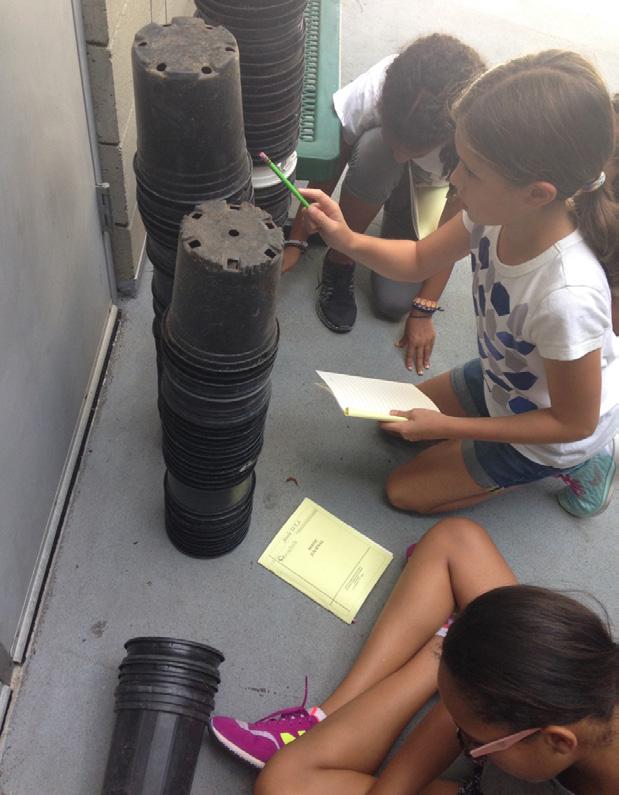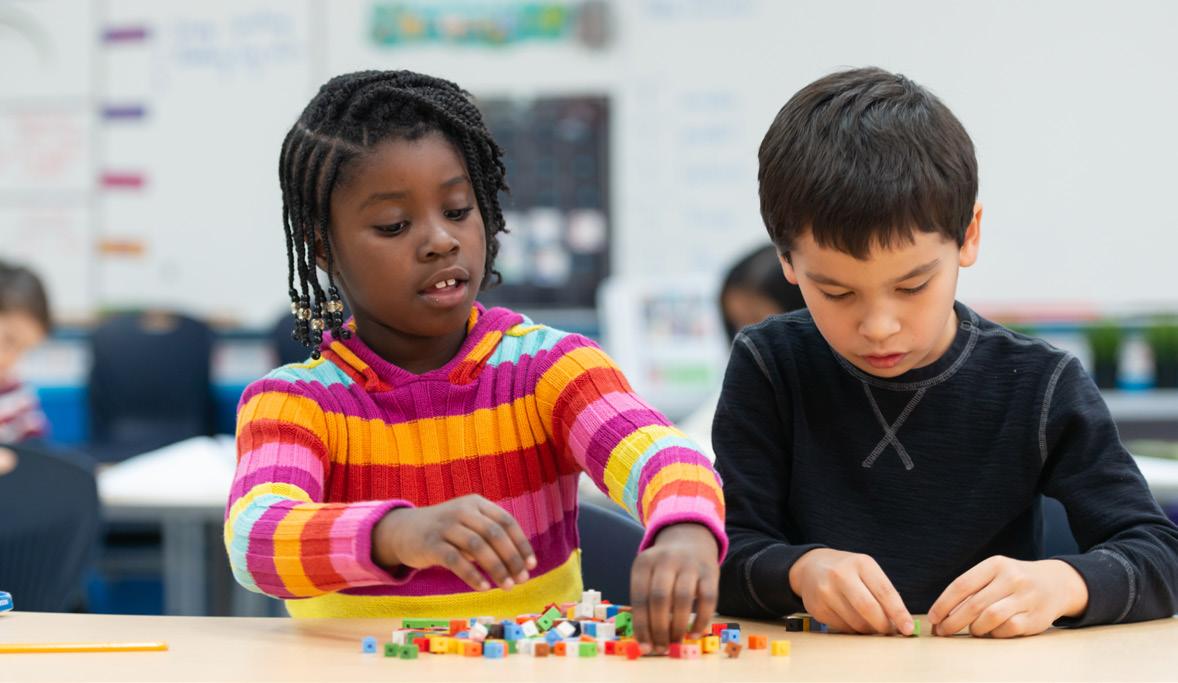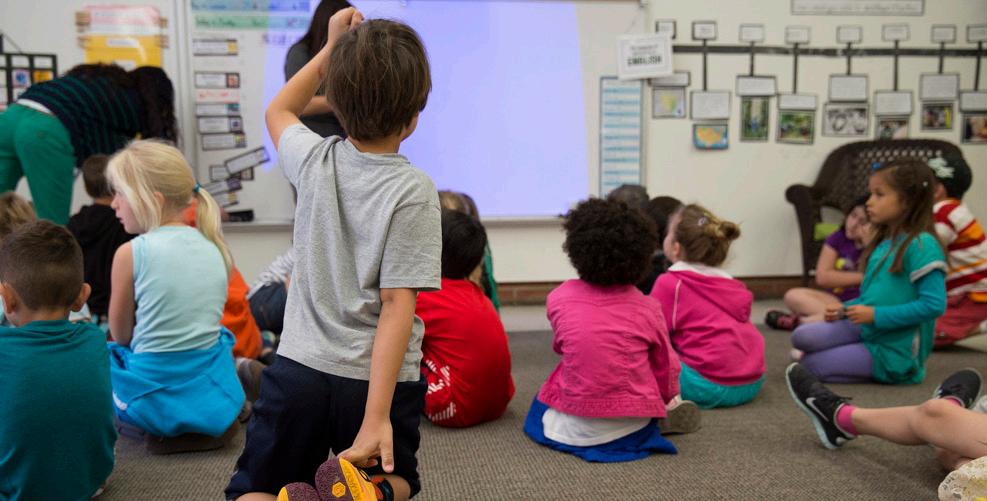
11 minute read
Honoring the Mathematical Thinking of Students
UCLA Education Professor Megan L. Franke and colleagues mobilize educators to strengthen teaching and learning in mathematics through COGNITIVELY GUIDED INSTRUCTION
by John McDonald
Advertisement

“My ultimate goal is to listen to the kids, to really listen, to find out what they know, what are they doing,” says Liz Romero, a third-grade teacher at Euclid Avenue Elementary in Boyle Heights. “They will tell you where to go.”
“They all know what a cookie is and what it means to share by breaking it in half. They have seen a burrito cut in half to share—or seen a cake or pie cut into pieces. They know what is whole and what is half. I want to know what they know, and to build on that,” Romero said.
Romero is talking about teaching mathematics using an approach called Cognitively Guided Instruction or CGI. The approach honors and builds on the robust mathematical understandings each child brings to school. In CGI, teachers gather information about the details of children’s mathematical thinking and use the information to guide the development of student mathematical thinking and understanding. In CGI, teachers invite students to solve problems in ways that make sense to them and to communicate their ideas. Teachers don’t just tell students the answer or formula and expect them to memorize it. Instead, they use their awareness of children’s mathematical thinking to help them develop a deeper level of understanding.
“The first time I saw CGI, I was like, no way, not with my kids. I think that’s the reaction with a lot of teachers,” Romero said. “Too often our mindset seems to be ‘our kids can’t.’ CGI has helped to change that. We can learn to really listen to our kids, to notice what they are doing, and to respond to what they are saying. We can shift to that admiring lens, to focus on what a student knows and can do well, not use a deficit lens. Once you start using CGI, there is no going back.”
Romero’s teaching and that of other teachers using Cognitively Guided Instruction draws greatly on the research and leadership of UCLA Education Professor Megan L. Franke, whose career has explored the mathematical thinking of children and how teachers can support and further student learning through cognitively guided instruction.
Franke began her educational journey as a third-grade teacher at a Catholic school in Venice, California where she soon grew frustrated with her efforts at teaching, especially in mathematics.
“When I was teaching I realized that I spent the year finding every way I could to show my students how to use the standard algorithm for addition and subtraction and that at the end of the year, a
“My teaching years also helped me to understand the complexity and nuance of teaching and I began to understand that there were going to be no simple answers to my questions about teaching. I also went to some pretty terrible professional development where it was not about our learning, but talking at us about nothing new.”
Motivated by that experience, she became a doctoral student and an associate researcher for the Cognitively Guided Instruction project at the University of Wisconsin, Madison, where she earned her Ph.D. in Educational Psychology. At Wisconsin, she had the good luck and opportunity to work with noted professor Tom Carpenter, an expert in children’s mathematics who is considered by many to be the father of Cognitively Guided Instruction. In the late 1980s and early 1990s, Franke joined with Carpenter, University of Wisconsin professor Elizabeth Fennema and other colleagues to conduct a series of research projects that today serve as a research base for Cognitively Guided Instruction.
Among other findings, in a series of studies (Carpenter et al., 1989; Fennema et al., 1993; Fennema et al., 1996) the researchers found that learning to understand the development of children’s mathematical thinking could lead to fundamental changes in teachers’ beliefs and practices and that these changes were reflected in students’ learning. These and other research findings have helped to inform and shape professional development and instruction in Cognitively Guided Instruction.
After moving to UCLA in 1993, Franke continued her research, seeking to understand and support teacher learning for pre-service and in-service teachers. She has studied how teachers make use of research-based information about the development of children’s mathematical thinking (Cognitively Guided Instruction) and how CGI supports student learning in mathematics. She is especially interested in how paying attention to students and their mathematical thinking can better leverage the resources of low-income students of color and support learning for all students.
“I’ve seen that CGI can empower teachers and students to see themselves as capable and confident in teaching and learning mathematics,” Franke says. “It’s an approach that respects teachers for the expertise they bring to the work and offers the opportunity to learn together. Teachers can take the research-based information about the development of children’s mathematical thinking as a base for hearing and seeing how their own students are

thinking and use that to build their mathematical thinking and confidence.”
Twenty-five years ago, Franke and colleagues at UCLA began a professional development program with the Lennox School District to help educators learn about Cognitively Guided Instruction and provide support for its use in elementary school classrooms. Today, that effort has grown into an extensive collaborative professional development program led by the UCLA Mathematics Project at UCLA Center X offering educators across Los Angeles County the opportunity to learn about CGI through partnerships with schools and districts as well as weekend workshops and summer institutes. The project engages educators in offerings that range from introduction to CGI, to more in-depth sessions focused on the use of CGI to further algebraic reasoning or learning about specific math topics like fractions.
Four years ago, the UCLA Mathematics Project entered into collaboration with the Los Angeles Unified School District to further the use of Cognitively

Guided Instruction in schools across the district. Beginning with ten schools, the LAUSD/UCLA CGI Action Research Project has grown to support 210 elementary schools and early education centers in the LAUSD. Building on an integrated program of research focused on the development of students’ mathematical thinking and instruction that influences that development, the project engages teachers in ongoing learning opportunities at participating school sites and in professional development sessions and workshops throughout the year. The project has engaged more than 5,000 LAUSD educators in CGI professional development, helping tens of thousands of students to develop positive math identities as they reason and learn about mathematics in ways that make sense to them and matter in their lives.
“What’s so powerful about CGI is it puts children and their math ideas at the center of teaching and redefines math teaching as truly student-led,” said Angela Chan Turrou, a senior researcher at UCLA who works on the project.
“Through CGI, teachers see children differently—as the bearers of great ideas —and they see their role as teacher differently—as a facilitator of a community that learns with and from each other.”
Initial data collected by the LAUSD UCLA CGI Action Research Project on student attitude and content knowledge, and teacher content knowledge, indicates that students’ attitudes towards math have changed positively and shows that students are using more strategies and more complex strategies over time. Teacher attitudes also show positive improvements.
“The LA Unified/UCLA Mathematics Project CGI Action Research Project is changing the way that teachers teach and students learn math. All students and teachers are honored for what they bring to the study of math and are capable of being mathematicians, so that math makes sense,” says Lisa Ward, who recently retired as LAUSD math coordinator and has helped to lead the CGI effort with the LAUSD since its inception.
In January 2020, more than 1,000 educators from across the LAUSD came to UCLA to celebrate their work with the CGI Action Research Project and develop new knowledge, strategies and skills for using CGI in their classrooms. And this spring and summer, hundreds of LAUSD teachers will take part in professional development opportunities hosted by the UCLA Mathematics Project.
Many of the workshops and institutes are taught by classroom teachers like Romero, who have learned about CGI through opportunities with UCLA and their experience in the classroom. They form an invaluable network of 150 teacher leaders who can share what they have learned with other teachers and offer ongoing support.
“The work we do depends upon the relationships we have formed and nurture within our community of teacher leaders, as well as the relationships and trust we intentionally build with the teachers we serve,” said Janene Ward, associate director of the UCLA Mathematics Project.
Franke and her colleagues at UCLA are excited about the collaboration with the LAUSD and are looking forward to expanding the effort to building a culture of ongoing learning around mathematics.
“This has been so impressive. Teachers are learning about their own students’ ideas, the resources they bring,

and how much students are capable of when given the opportunity,” Franke said. “I am seeing thousands of teachers and principals who want to continue to participate and learn about CGI. They are asking questions, making connections to their practice and their students, and they are asking for more.”
“CGI is not mine to define and it is constantly evolving. But there is a great deal of consistent research (CGI as well as others) that shows that when teachers have knowledge of children’s mathematical thinking their students learn. And there are a number of studies that positively relate participation in professional development in Cognitively Guided Instruction to teacher and student learning.”
“We can build on that. As we move forward it is tremendously important that we take time to think and talk about our work as a community and continue to challenge each other.”
A Lesson in Fractions
In Liz Romero’s third-grade classroom at Euclid Avenue Elementary in Boyle Heights, the students are learning about fractions. Romero’s goal for the lesson that day is to see if they understand the concept of wholes, and the equivalence of fractions in relationship to wholes. Having already demonstrated success in building foundational understandings of fractions, the students are stretching into new territory related to equivalence and unit fractions. As she begins, the students are spread out casually on a rug at the front of the classroom. Romero is friendly, almost casual with the students, but her teaching is intentional. She asks them, “Who taught you yesterday?” “Ms. Hernandez!” the students call out. (Ms. Hernandez is a student teacher working in Romero’s class.) “Yes, yesterday was her first full day of teaching.
So afterwards we went out to dinner to celebrate. And we got dessert,” Romero says with a grin. “What do you think we got for dessert?” she asks.
“Cake!” says one boy excitedly.
“No, we got pie, and it was good,”
Romero says with relish, and the kids giggle a little. “Your goal for the day is to figure out who ate more pie,” she says.
“Who do you think ate more pie,” she asks them, and hands shoot up.
She asks them some questions.
“How would you know who ate more pie?” she asks.
“What do you notice?”
“How many pieces were there?”
“How many pieces did I eat?”
“How many pieces did Ms. Hernandez eat?”
“How much did we have left?”
She hands them each a piece of paper that says:
Who ate more pie?
Ms. Hernandez ate 2/3 of pie.
Ms. Romero ate 4/4 of pie.
Show how you know.
Show how you know.
The students quickly move into groups at small round tables. They work individually at first. Some students begin by drawing two circles, others draw two rectangles and divide one into three pieces the other into four pieces. Some label them Ms. H. and Ms. R. They begin to shade in the pieces with their pencils.
Romero moves among the students, working individually, asking, “What did you notice?”
“Four pieces of pie makes a whole pie,” says one girl, “you ate the whole thing.”
“What about Ms. Hernandez, did she eat the whole thing?” The student nods, but is quiet, a little unsure.
Romero quickly writes out a number sentence on a pad of paper she carries, 1/3 + 1/3 = 1 and shows it to the girl.
“Is this true?” she asks.
The girl shakes her head to signal no.
“Do you want to revisit your thinking,” Romero asks.
The girl nods, her face breaking into a big smile.
At their tables, the students begin to work in groups, talking with each other about what they notice, what they did, who ate more pie and sharing what they know.
Shortly, they move back to the carpet, with one girl moving to the front of the room, sitting at an overhead projector. It is her turn to demonstrate and share her work.
“First I drew two circles,” she says.
“One for Ms. H. One for Ms. R. Then I made pieces. One has three pieces— One has four pieces. I shaded them in. And I noticed that Ms. R. ate more.”
Ms. Romero asks the students to turn and talk about what the girl did. She asks them questions, writing them out on the board.
“Is this true: ¼ + ¼ + ¼ = 1? How would I make it true?”
The students talk about their answers, how they found them, and share their work with each other.

